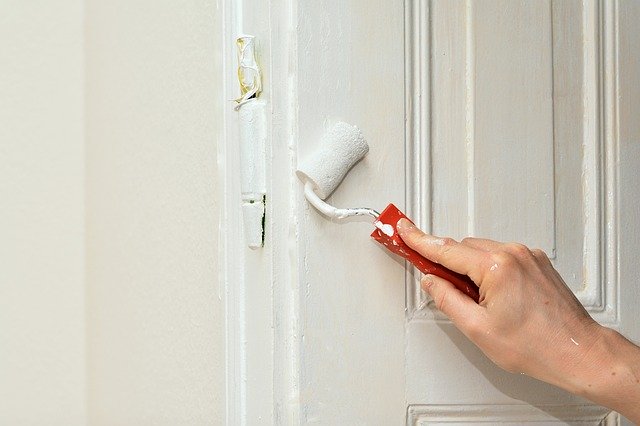Painting ceilings and Walls is another challenging task for DIY homeowners.This article is an excerpt form workbook called “HOW TO BUILD A HOUSE” by “LARRY HAUN“.
our prairie home seldom, if ever, had any paint on the exterior. The siding became as grained and leathery as the faces of the inhabitants. Indoors, we sometimes used a dry powder, called Kalsomine, that we mixed with water and used to paint the ceilings and walls. Kalsomine came in different colors, which added a bit to our rooms and to our lives.
After I left home, it seemed that the only interior paint color in existence was Navajo White. For years, the interior of every house we built was painted this off-white color. It was a breath of fresh air to see all the bright colors that exploded in the late 1960s and early 1970s. From bland to bright to subtle pastels and now back to Navajo White-so much for progress.
TIP
Plastic wrap makes good short-term storage for brushes and rollers. When you stop painting to have lunch or simply take a break, there’s no need to clean your brunch or roller. Instead, just wrap it in plastic until you get back to work.
PAINT PREP IS THE KEY TO A GOOD PAINT JOB:
Professional painters know from experience that the biggest part of a paint job is the preparation. You don’t just grab a bucket of paint and a roller and have at it. Take time to remove doors from their jambs before you start painting the walls and ceilings. Number or label the doors so you’ll know later where each one belongs.
Some drywall jobs create lots of dust that must be removed before you can paint. I use a vacuum cleaner to remove dust from the walls and ceilings, but a room or a pole sander wrapped with a cotton cloth also works well. Take it easy, because topping compound is relatively soft and easily scratched. Pay special attention to dust in the corners. Remove any drywall mud or dust left in electrical outlets, and scrape up any globs of drywall compound.
PAINT PREP IS THE KEY TO A GOOD PAINT JOB:
My hand likes the fit of a long-handled brush. But bristles, not handles, are what make a good brush. Brushes with natural bristles, usually hog’s hair, work best with oil-based products. Synthetic-bristle brushes work best with water-based paints. Soft nylon bristles are a good choice for finish work, whereas stiffer poly bristles are better for painting rough or textured surfaces, such as siding. A combination of nylon and poly bristles is a good choice. A 1-in. or 2-in. Brush with bristles cut at an angle gives you more control for cutting in trim.
A quality brush can last for years if you take good care of it. That means cleaning it thoroughly each time you use it. First, remove most of the paint from a brush by painting on some cardboard or newspaper. If you’re using oil-based paints, then you must wash the brush in paint thinner. Latex and acrylic paints can be washed in lukewarm soapy water. Once the brush is clean, you can either spin it dry with a brush spinner (available at most hime centers and hardware stores) or just let it dry naturally. A wire brush and a brush comb are good to have on hand for removing hardened paint and straightening the bristles. Finally, once the brush is dry, store it in its wrapper until you need it again.
That have dried on the floor. Drywall mud left on the floor can work its way up through a car-pet. Then vacuum up all the dust. Cover the tub or shower with a protective sheet of inexpensive 1-mil plastic, often called painter’s poly, affixed with masking tape.
APPLY THE PRIME AND FINISH COATS:
My advice for buying paint and brushes is the same as for buying any other tool and materials: Talk to contractors and knowledgeable folks working behind the counter where you buy your supplies. Then buy the best you can afford. A knowledgeable paint supplier will help you choose primer and finish paints that are compatible; you’ll also get advice on the best brushes and rollers to use with your paint. For some basic background information, see the sidebar on p.231. A well-built house deserves a quality paint job. Spending more money on high-quality paint can actually save you money down the road, because good paint covers better and holds up well over time.
When using several gallons of a single color. Mix them together in a 5-gal. Bucker to ensure uniformity. Keep the pigment mixed by stirring well before painting and throughout the day.
CUT IN AROUND THE EDGES:
The two basic techniques for painting both ceilings and walls are cutting in and rolling. “Cutting in “ means brushing paint onto areas that can’t be reached with a roller. Painters usually begin working from a ladder, cutting in the corners where the ceilings meet the walls. Use a 3-in. or 4-in. Brush to make a cut-in band all around the ceilings and walls, as shown in the photo at left. This band will be overlapped when the large open spaces are painted with a roller. Professional painters prefer to use a brush for cutting in, but it can also be done with a paint pad, which is basically just an absorbent sponge on a handle.
Take your time. Good brushes are easy to load with paint. Rather than painting with a full can of paint, Rather than painting with a full can of paint, painters like to use a bucket that’s about half full. This allows them to dip the bristles about halfway into the paint, then fill the inner part of the brush with a few gentle slaps of the brush against the inside of the can (see the photo below). Apply paint in relaxed, even, gentle strokes.
TIP
Avoid over loading. Inexperienced painters often make the mistake of over-loading brushes (and rollers) with paint. All this does is make a bigger mess. With paint splattering, dripping, and running down to you elbows.
Load your brush with paint. A good brush can hold plenty of paint. Using a half-full paint bucket allows you to dip and load your brush by tapping it gently against the inside of the bucket.
Continue reading about Ceiling Repair

